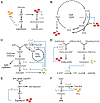Dynamic control in metabolic engineering: Theories, tools, and applications
- PMID: 32927059
- PMCID: PMC8015268
- DOI: 10.1016/j.ymben.2020.08.015
Dynamic control in metabolic engineering: Theories, tools, and applications
Abstract
Metabolic engineering has allowed the production of a diverse number of valuable chemicals using microbial organisms. Many biological challenges for improving bio-production exist which limit performance and slow the commercialization of metabolically engineered systems. Dynamic metabolic engineering is a rapidly developing field that seeks to address these challenges through the design of genetically encoded metabolic control systems which allow cells to autonomously adjust their flux in response to their external and internal metabolic state. This review first discusses theoretical works which provide mechanistic insights and design choices for dynamic control systems including two-stage, continuous, and population behavior control strategies. Next, we summarize molecular mechanisms for various sensors and actuators which enable dynamic metabolic control in microbial systems. Finally, important applications of dynamic control to the production of several metabolite products are highlighted, including fatty acids, aromatics, and terpene compounds. Altogether, this review provides a comprehensive overview of the progress, advances, and prospects in the design of dynamic control systems for improved titer, rate, and yield metrics in metabolic engineering.
Keywords: Biosensors; Dynamic metabolic control; Dynamic metabolic engineering; Genetic circuits; Synthetic biology.
Copyright © 2020 The Authors. Published by Elsevier Inc. All rights reserved.
Conflict of interest statement
Declaration of competing interest
None.
Figures




References
Publication types
MeSH terms
Grants and funding
LinkOut - more resources
Full Text Sources
Other Literature Sources

